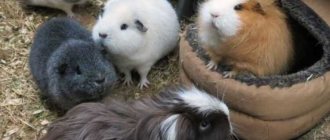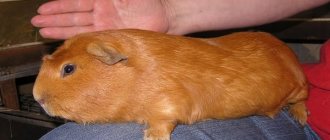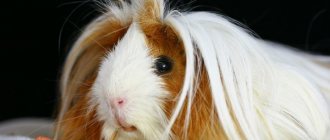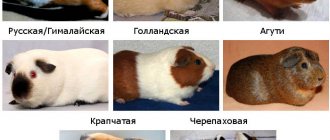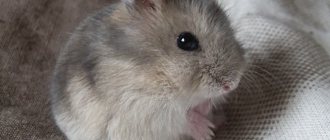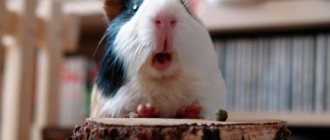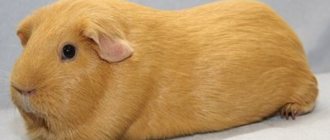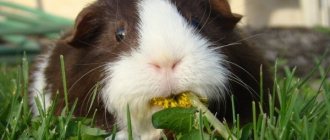Review author: “ZooVita”
Sooner or later, every person faces the choice of a pet. And after cats and dogs, some of the first animals that come to mind are all kinds of rodents.
A special place among them is occupied by the domestic guinea pig. These cute and friendly animals get along well with people, are devoid of aggression, are very clean and are considered long-lived among their own kind.
History and origin
Guinea pigs were brought to Europe in the 18th century from America. They were domesticated and kept as ornamental pets. In their homeland in South America, guinea pigs live in entire colonies of 20-25 individuals. Each colony has its own leader, who protects his possessions and the flock.
Guinea pig breeds and colors
While rats and hamsters are all the same, the variety of breeds of these rodents is simply mind-boggling. You can spend the whole day looking at photos of guinea pigs. And these will be only the most famous and common ones!
The American pig is the most common and oldest variety on the market. The coat of this breed is short, smooth and shiny. It fits tightly to the rodent's body and can have a completely different colors.
The Abyssinian breed is famous for its rosettes all over its body. The fur on the animal's skin is wrapped in a circle and forms a vortex. The number of such sockets can reach 6-10 pieces.
They are located chaotically throughout the body, with the exception of the head and abdomen of the animal. The coat color can be either monochromatic or combine several colors at once: white, black, red.
The Peruvian pig deserves special attention. Representatives of this breed boast silky and record-long hair. In some individuals, the hair length reaches 50 cm. Another feature of this breed is that the hair grows from the sacrum to the head and hangs over the eyes.
Cornet and Sheltie are also long-haired breeds. It is noteworthy that babies are born with short fur, and only at three months does it begin to grow back. The coat grows from the face to the tail and can lengthen by 2.5 cm every month. It is recommended to periodically trim the pigs to avoid tangles.
But among the pigs there are also completely bald representatives. The skinny guinea pig is easily recognizable due to its complete lack of hair. Only on the face and paws there are small areas with sparse hair. The skin of these rodents is very soft and pleasant to the touch.
These are not all breeds of guinea pigs. The selection process can be long and painful, because they are all beautiful and unique in their own way.
Varieties of coat color
Cavies have a wide variety of coat colors and unusual colors.
- Agouti. This color can be found in both long-haired and short-haired pigs. This is the so-called “wild” color, in which each hair is divided into three parts by color. There are several tones of agouti: chocolate, copper, cream, yellow, golden, silver.
- Himalayan. Color reminiscent of Siamese cats. There are two tones of Himalayan color in rodents: with black and brown spots on the face, ears, and paws.
- Dalmatian. The main color of the fur coat is white, but it is complemented by dark spots that are no larger than peas in size. Spots dot the entire coat, on the back and sides they are larger and more abundant, on the abdomen they are smaller and less common.
- Buff. Buffalo color. The color of the coat is specific, rich brownish-yellow. This color can be monochromatic or combined with spots.
- Dutch. Two-color, black and white or brown and white color, characteristic only of smooth-haired pigs. The head and back are dark, and the legs and middle of the body are light.
- Tortoiseshell. An original color in which the coat is tricolor, consisting of large, clearly defined white, red and black spots. Breeders jokingly call pigs with such a cute coat “cakes.” The tortoiseshell color is characteristic exclusively of smooth-haired rodents.
- Roan. A beautiful color in which white hairs are evenly interspersed into the main color of the coat. With a main coat of black color, the color is called blue, and with a main color of red, it is called strawberry.
- Tan. In animals of this color, the hair around the eyes and on the abdomen is different in color from the hair on the rest of the body.
- Brindle. This color means that the pig's coat consists of only two colors - black and red. Black and red spots and stripes should be evenly distributed throughout the coat.
- Tan and Fox. New colors. With the tan color, there is black tan around the eyes, ears, muzzle, chest and belly of the animal; with the fox color, there is white tan in the same places.
As can be seen from the photos and descriptions, guinea pigs are cute and cute creatures, surprising with the variety of colors and shapes of their fur coats. To acquire a healthy and purebred friend, the purchase must be made in the nursery, and not from hand. Only purebred individuals are sold in nurseries.
Guinea pig lifespan
Another reason to choose a guinea pig as a pet is its relatively long lifespan. On average, representatives of this class can live 6-8 years in captivity. While hamsters live 1-2 years, and rats - 3-4 years.
Belonging to one breed or another plays an important role in the race for life. Representatives of short-haired breeds can live up to 8 years. Long-haired beauties live on average 5-6 years, just like rosette Abyssinians. But hairless guinea pigs can live only 5 years due to weak immunity.
The absence of genetic diseases and simple care makes smooth-haired breeds long-lived among other breeds.
Please note ⭐⭐⭐
Domestic duck: varieties and rules for caring for them, how to breed ducks at home
- Domestic hedgehog: rules for keeping it at home, tips for choosing an animal (120 photos)
Domestic ferret (ferret): features of keeping and caring for the animal, standards, types of breeds, what they eat, how long they live (photo)
But the main and decisive factor influencing life expectancy is the living conditions of guinea pigs.
Smooth fur and smooth skin
Representatives of smooth skins
Baldwin guinea pigs are completely hairless and have smooth skin. Skinny has fur on his nose and paws, from birth to the end of his life. The main features of care are compliance with the temperature regime and a more varied diet (the diet should be higher in calories than that of other pigs). Read more about smooth guinea pigs in the article Baldwin Guinea Pig.
Left - Skinny, right - Baldwin
Self breed guinea pig
The Self breed has English roots and dates back to the 1920s. These are representatives with short hair, a relatively compact build, and a color in which only one color predominates. Moreover, even the ears, eyes and paw pads must match the color of the coat. Cute selfies can be both calm and active. Their advantage is the lack of aggressiveness even in a pair of males. A good option for a purebred animal for those who are thinking about which guinea pig is best for the home.
Agouti
Agouti is almost the ancestor of all guinea pigs. At the same time, there is a type of Agouti color that is characteristic of other breeds. The main feature of the color is the ticking. At the base of the hair, almost at the skin, the hair has one color, in the middle it turns into a second color, the tips have a third shade, most often darker. Ticking is present everywhere, even on the paws. Agoutis are also highly trainable.
Crested
The American Crested is so called because of the rosettes on the top of its head that are colored white. They are also called crested guinea pigs. The animal itself has short, smooth fur, without any partings. Crested dogs do not have any pronounced character traits; they live well with almost any kind of piggyback, and they are also favorable towards humans.
Features of keeping at home
These animals need a spacious cage that will be adapted to their lifestyle. The ideal option would be a one-story cage 130-150 cm in length. Definitely a cage, and not an aquarium or terrarium, because... In a glass box, an animal can overheat and die.
The cage can additionally be equipped with a wooden house, tunnels, bridges and all kinds of beds and hammocks. It is important that all materials are natural.
Sawdust or special wood pellets are usually used as bedding. They absorb moisture perfectly. In addition, rodents willingly grind granules, grinding down their teeth in the process.
The filler must be laid in a layer of at least 5 cm and changed as it gets dirty, but at least once a week. Pigs are very clean and go to the toilet in the same place.
The cage with the pet must be installed in a place where there are no drafts or open sunlight, because... it is harmful to the health of rodents. It will also be good if the pig can see its owner, so that the animal does not grow up wild and timid.
Please note ⭐⭐⭐
Domestic horse: description of breeds, types, features of maintenance and care, colors, what they eat, how long they live (140 photos)
Domestic goat: breeds with names, rules of care and breeding at home, many photos and features of an unpretentious animal
- Domestic pig: description of how to keep and care for it at home. Breeds, sizes, what they eat, habits (115 photos)
All in rosettes - Abyssinian
It is very easy to distinguish Abyssinians - they are completely in rosettes, the hair is not very long, about 3-4 centimeters. This coat does not require additional care. There should be eight rosettes, evenly distributed throughout the body. Abyssinians have a more active character and are big fans of running. They are friendly towards the owner, but they get into fights with their relatives much more often.
Nutrition
The lifespan of rodents also directly depends on what guinea pigs eat. The basis of the daily diet is hay, and in the summer - grass. It should be in the cage constantly and regularly replaced with a new one.
In addition, it is worth diluting the diet with fresh vegetables, fruits and seeds. You can also pamper your pet with dried plant roots and a twig from a tree. Do not give dried fruits, confectionery, flour, cereals, radishes, potatoes, legumes, peaches, bananas and citrus fruits.
The water bowl should also always be filled. The automatic drinking bowl is placed at muzzle level to make the animal comfortable. Or use a ceramic bowl, which will be heavy and stable.
Features of feeding
It is known that guinea pigs are domesticated rodents that feed on dry grass. The basis of their diet is hay. In addition, animals eat grain feed:
- oats;
- corn;
- barley;
- wheat;
- sunflower seeds.
It is beneficial for animals to eat vegetables and fruits, as well as fresh herbs. These are valuable sources of vitamins and microelements. In winter, rodents are given grass pellets or grain sprouts. The diet must include branches of fruit trees.
Guinea pigs should not be offered food of animal origin, as well as potatoes, red beets, and citrus fruits. Confectionery and bakery products are strictly prohibited.
Health
Guinea pigs are not known for their Siberian health. Infectious diseases are almost always fatal. The consequence of a draft can be pneumonia, and direct sunlight can lead to heat stroke.
You should also carefully monitor your diet and avoid foods that can lead to fermentation and bloating.
Another factor that can greatly affect your pet’s well-being is the lack of company. Guinea pigs live in colonies and cannot stand being alone. They can literally die of boredom.
Please note ⭐⭐⭐
- Domestic rabbits: breeding, care rules, description of breeds + 110 photos
Chickens at home: care rules, breeding instructions, overview of breeds and species with photos and names
Chinchilla: features of keeping at home, colors, photos, character, how long they live, what they eat, how to care for them, interesting facts
To keep your pet happy, you need to buy at least a couple of rodents. Same-sex is possible if there is no goal of breeding.
Natural enemies of skinny
Photo: What skinny looks like
Skinnies have no natural enemies, as they are domestic animals. Skinnies are more vulnerable to elements and factors that cause their health to deteriorate. They are sensitive to low and high temperatures. They should be placed in a room with normal room temperature. Feeding skinnies properly and placing them in a moderate temperature room allows them to maintain a normal body temperature.
Because they lack hair, they are more vulnerable to injury, infection, and skin lacerations. Skinnies with exposed skin should be handled with care as they are extremely vulnerable to injury and infection. Therefore, as a necessary precaution, they should be stored indoors in a controlled environment. They should be introduced to sunlight, but from then on, their playful and curious nature must be monitored. They may end up causing injury to their delicate bodies.
Their most significant difference is that skinnies must be kept indoors. Due to their lack of fur, they have trouble maintaining body heat when they are in cooler environments. They also do not cope well with drafts. Skinny bedding should be soft and free of sharp objects and surfaces. They are truly sensitive and any minor vulnerability they encounter must be addressed to ensure their overall safety.
Reproduction and offspring
When a pair of guinea pigs live in a cage, the offspring will not be long in coming. A female can give birth to up to two litters in a year. Each pregnancy lasts about 70 days and brings 4-6 babies.
During pregnancy, the male should be removed. After birth, the female feeds the offspring with milk for a whole month, after which the babies become ready for independent life and should also be separated.
A guinea pig can become a wonderful pet - a favorite of children and adults. If you provide the animal with decent care, it will delight the whole family for many years.
Habits
In most cases, very calm and affectionate animals. Rodents show their character in an unusual way. If they are happy, they may jump around the cage and make squeaking noises.
Small individuals are afraid of people and constantly hide in a safe place. It is necessary to accustom the animal to hands carefully without stress.
Aggression manifests itself only after the birth of offspring. For a month, the female will not let anyone near the babies and will defend herself in all known ways.
If the pig is chewing on the cage, then it is bored or there is not enough space. You can expand the cage, play more often, or add another individual. It is dangerous to chew on a cage.
The norm for these animals is to eat their own droppings. Thus, the animal saturates its body with the remaining beneficial substances.
But it’s better to clean the cage in time and expand the diet with vitamins. Your pig may chatter his teeth, which is a sign of stress. It is necessary to temporarily remove irritants.
